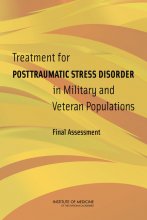By the Numbers - June 23, 2014
9.2%
The percentage of all VA users in 2012 who sought care for PTSD, according to a new report from the Institute of Medicine -- Treatment for Posttraumatic Stress Disorder in Military and Veteran Populations: Final Assessment.
Between 2004 and 2012, the percentage of all active-duty service members with a diagnosis of PTSD increased from 1 to 5 percent. In 2012, 13.5 percent of U.S. Army service members had PTSD, as did 10 percent of Marines, 4.5 percent of Navy personnel, and 4 percent of Air Force personnel. The same year, more than half a million veterans of all eras sought care for PTSD through VA health care services—making up 9.2 percent of all VA users. Almost 24 percent of these veterans (119,500) had served in the Afghanistan and Iraq conflicts.
The report indicates that, while the DoD and VA "have made a sustained commitment to PTSD management and invested substantial financial and programmatic resources to provide care to service members and veterans...a lack of standards, reporting, and evaluation significantly compromises these efforts."
The IOM's recommendations include:
- "an integrated, coordinated, and comprehensive PTSD management strategy"
- "a measurement-based PTSD management system that documents patients’ progress over the course of treatment and long-term follow-up"
- "an adequate workforce of mental health care providers—both direct care and purchased care—ancillary staff, and resources to meet the growing demand"
- "evidence-based treatments as the treatment of choice for PTSD...delivered with fidelity to their established protocols"
- "a central database or other directory for programs and services"
- increased "engagement of family members in the PTSD management process"
- "research priorities in DoD and VA (that) reflect the current and future needs of service members, veterans, and their families"
9.2%
The percentage of all VA users in 2012 who sought care for PTSD, according to a new report from the Institute of Medicine -- Treatment for Posttraumatic Stress Disorder in Military and Veteran Populations: Final Assessment.
Between 2004 and 2012, the percentage of all active-duty service members with a diagnosis of PTSD increased from 1 to 5 percent. In 2012, 13.5 percent of U.S. Army service members had PTSD, as did 10 percent of Marines, 4.5 percent of Navy personnel, and 4 percent of Air Force personnel. The same year, more than half a million veterans of all eras sought care for PTSD through VA health care services—making up 9.2 percent of all VA users. Almost 24 percent of these veterans (119,500) had served in the Afghanistan and Iraq conflicts.
The report indicates that, while the DoD and VA "have made a sustained commitment to PTSD management and invested substantial financial and programmatic resources to provide care to service members and veterans...a lack of standards, reporting, and evaluation significantly compromises these efforts."
The IOM's recommendations include:
- "an integrated, coordinated, and comprehensive PTSD management strategy"
- "a measurement-based PTSD management system that documents patients’ progress over the course of treatment and long-term follow-up"
- "an adequate workforce of mental health care providers—both direct care and purchased care—ancillary staff, and resources to meet the growing demand"
- "evidence-based treatments as the treatment of choice for PTSD...delivered with fidelity to their established protocols"
- "a central database or other directory for programs and services"
- increased "engagement of family members in the PTSD management process"
- "research priorities in DoD and VA (that) reflect the current and future needs of service members, veterans, and their families"

